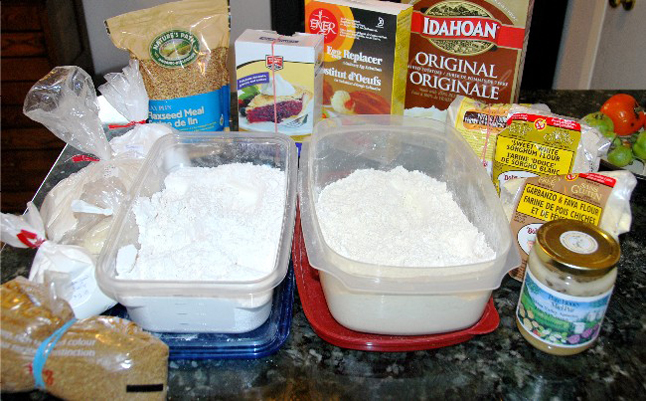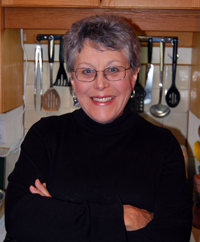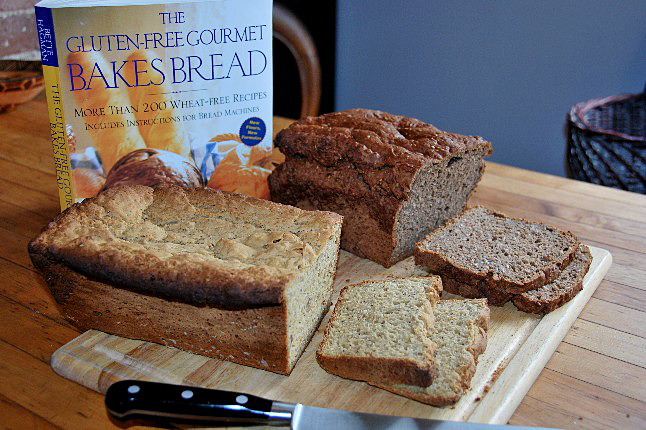

Bob’s Red Mill Hearty Whole Grain Bread from mix
Stoker Four Flour Bean Gluten Free Bread (adapted from Bette Hagman)
Well, Hurrah! Gluten-free products are in Revelstoke supermarkets. Cooper’s now stocks GF mixes, flours, egg replacer, and xanthan gum (one of several possibilities that will make non-wheat flour rise.) Celebration for celiac sufferers and for those who wish to avoid wheat products! Mountain Goodness has stocked these for some time, and Southside stocks mixes that are GF, DF and AF (dairy-free and allergy-free.)
Celiac disease (aka sprue, coeliac) is an autoimmune disorder of severe digestive difficulties. It is the result of the body’s inability to process the proteins in wheat gluten — found throughout the Triticeae family, which includes barley, rye and spelt. Celiac disease is a spectrum disorder, affecting some sufferers with major gastrointestinal issues and others with less intensity. Wheat allergy is a different condition but also results in wheat avoidance.
Not only celiacs and wheat allergic people seek gluten-free baked goods. Wheat Belly the book has upped the ante, and has contributed to a general trend towards foods that many associate with allergies and other digestive ailments. Medical opinion on wheat avoidance is still out, and even author William Davis, M.D. doesn’t recommend replacing wheat products with the gluten-free mixes available — these simply provide different carbs, which “will make you fat,” he says.
For celiacs however, and especially for families with a celiac child, the new mixes are a huge boon. Treats like birthday cake and cookies have become part of the culture, and the inability to enjoy these can represent, from a child p.o.v., a serious deprivation. A lunchbox sandwich used to be a problem and is no longer, and muffins, cake and brownies are available in mixes too.
The downside is that the mixes are expensive. Cup-4-Cup, for example, a mixed non-wheat flour product from California, costs $12 for 3 lbs — or $4 per lb. Compare this to ordinary all-purpose wheat flour, available at Cooper’s this week for $3.99 for 5.5 lbs.—basically five times cheaper.
It does depend where and what you buy. Bob’s Red Mill tapioca flour costs $6.99 at Coopers for about 600 gms, whereas at Mountain Goodness the enterprising stoker can obtain 475 gms for $1.90. The difference may be that Bob’s Red Mill is gluten-free operation, so can guarantee a non-contaminated product. Tapioca flour is a key ingredient in most gluten-free baked products; it’s nothing more complicated than cassava flour — cassava, or yucca as it’s known in Latin America, is the plant — a large tuber, brown outside and white inside — from which laundry starch derives — pure carb. So it shouldn’t be expensive.
Buying gluten-free prepared baked goods can also be expensive. La Baguette makes the best gluten-free loaf I’ve tasted with flour imported from Italy; it’s brown and rich and dense and flavourful — and at $10 a loaf it’s great for visitors and small families, but it’s not going to work as a staple for larger families. Several vendors at Revelstoke’s community market also sell gluten-free breads — acceptable products, but also not inexpensive.
I surmised it would be less costly to make these items at home, and have been experimenting with recipes from Bette Hagman’s The Gluten-free Gourmet Bakes Bread ($23.99 at Mountain Goodness.) Hagman gives four basic flour mixes, one using garfava (garbanza and fava beans) and sorghum flours, the others various rice/potato/tapioca combinations. Bette Hagman is justifiably famous in gluten-free circles: a celiac since childhood, she has written four gluten-free recipe books and has garnered praise from the medical profession as well as cooks everywhere. This book is a treasure — I have learned a lot from it, and am still on the curve.
Bette Hagman’s method involves making the flour mix using garfava, sorghum, tapioca and corn flours, then mixing fourteen wet and dry ingredients. I did all by hand rather than in a bread machine, an option for all Bette’s recipes. The mix is certainly easier and faster.
Is it cheaper to cook from scratch? Not necessarily. Stocking up on the long list of ingredients has cost a lot, though I won’t have to buy again soon any Egg Replacer, xanthan Gum or potato flakes (known here — after 8 staff members at Coopers searched high and low for “flakes,” as instant mashed potato.) And now that I have these flours, of course, it’s away to the races.
One outcome of making scratch recipes is that you sure know what goes into the bread: bean flours, tapioca, rice flour and cornstarch—horrific until you consider the composition of a wheat grain once the bran and the germ are removed as they are for normal white flour: most of white flour is just starch.
Here’s my take on the outcomes:
Bob’s Red Mill Hearty Whole Grain Mix
This loaf looks terrific when it comes out of the oven, and rises up in the middle like regular bread. It’s dark brown, as a result of the cocoa powder in the mix—a great idea. It is of course easier to make than bread made from scratch, and at $6.99 for the package, probably cheaper than the initial outlay of all the stuff you have to get for just one or two loaves of scratch gluten-free bread. Even the yeast is included in the package. You add only oil, water, eggs and vinegar.

However, the result was less satisfactory than anticipated. The bread has a good nutty flavour — quite like dark brown ale. The look of it is good — even crumb, dense with buckwheat and whole grain teff. But the springyness that Bette Hagman tries so hard to obtain is missing — and it’s that spring—the way you bite into the bread and find a little resistance — that’s missing. This texture is cake-like. It’s not unpleasant, and if you like unyeasted breads such as corn bread or soda bread, you’ll find this similar.
Bette’s Oregon Bread with Four-Bean Flour
I made this twice, as the first effort was like a brick, flat on top, and too sweet. The second time, I cut the honey and added molasses, changed walnuts to sunflower seeds, and created a sponge with the water and yeast rather than mixing the yeast in with dry ingredients. I also changed the timing slightly to account for Revelstoke’s altitude and climate (damp, on baking day.)
The result: a springy, nicely-crusted loaf, pumpkin coloured, that toasts almost like real bread but faster with a tendency to burn at the crust. The taste is nutty, from the sunflower and sesame seeds, and pleasant. It doesn’t have a loaf shape — still a brick. The dough (which is like cake batter — you can’t knead it nor is there a reason to, as kneading aims at developing the gluten, and there is non) does not rise to the dome-shaped top that we expect in wheat bread. But the texture and the crumb are nicely chewy, not dry and crumbly. The bread is moist but not wet, with some resistant when you cut or bite into it. My number one taster liked it more than any other GF he’s eaten.
Word of warning: after testing these garfava loaves with dinner, our guts burbbled like a little hookah pipes all night long — the beans, doing their beany thing.Here’s the recipe, with my adjustments and a title for Revelstoke.

Stoker Four Flour Bean Gluten Free Bread
Make a yeast mix of
2 ½ tsp traditional dry yeast granules
1 ½ cups water at 110° F
½ tsp white sugar
Stir until sugar dissolves and let the yeast and sugar sit in the water in a large bowl until the yeast begins to froth and forms a cloud on top; stir together.
Mix up the wet and dry ingredients separately:
2/3 cup garfava bean flour
2/3 cup sorghum flour
1 cup cornstarch
1 cup tapioca flour
2 ¼ tsp xanthan gum
¾ tsp salt
1 ½ tsp unflavoured gelatine
1 ½ tsp egg replacer
1 tbsp brown sugar
1/3 cup chopped sunflower seeds
1 ½ tbsp sesame seeds
1 ½ tsp poppy seeds
1 ½ tsp flax meal
1 tsp white sugar
Wet ingredients:
1 egg plus 2 egg whites
1 tbsp honey
1 tbsp molasses
3 tbsp olive oil
½ tsp vinegar
Mix the wet ingredients into the yeast mixture and stir.
Use a kitchen mixer if possible, or stir vigorously by hand then beat with a whisk: add the dry ingredients to the wet, and beat for 4 minutes.
Set your oven to WARM only (not more than 190° F. )
Prepare the pan: if possible use a standard bread loaf pan 22 cm x 12 cm. Oil the pan, then line it with parchment paper, cutting and folding the paper so that it comes up the sides. Generously butter the inside of the paper with oil or margarine or butter. (If you don’t use parchment or at worst waxed paper, the bread sticks to the pan, is hard to get out and even harder to clean.)
Pour the cake-like batter into the bread pan, filling it about half full. Use any leftover dough to fill muffin cups lined with well buttered muffin papers, or buttered silicone muffin cups. Set the loaf to rise in the warming oven and leave it for about 30 minutes. Depending on the heat of your warming oven, you may have to turn the heat off after 15 minutes. The loaf needs to be in a warm but not hot place—the top of your fridge might work, if you cover the loaf with a lid that leaves room for air but not cold drafts to circulate. The dough should double in size.
Preheat your oven to 375° F. Cover loosely with a piece of foil. Bake the loaf for 40-50 minutes. The bread is cooked when a skewer inserted right into the middle comes out clean.
Cool before slicing.
Next week: GF Sourdough Bread (my starter is bubbling on the counter) and GF Sticky Cinnamon Buns (call these irresistible.)




